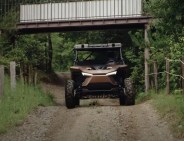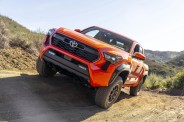This may look like your average, fourth-generation “N400” Tacoma. But it isn’t. Rather, under the hood of this rad-looking SEMA concept lies the sort of witchcraft and wizardry from the future.
That would be hydrogen fuel-cell technology, which is indicated by the “H2” portion of the Tacoma H2-Overlander Concept. Toyota just revealed the truck as one of its many debuts at this year’s Specialty Equipment and Manufacturers’ Association Show in Las Vegas.
While the prospect of a Tacoma-based overlander is nothing new, the H2-Overlander Concept revitalizes another still promising prospect. Which interestingly, isn’t new, either.

Hydrogen fuel-cell technology isn’t dead yet
The Tacoma H2-Overlander Concept may sport the usual upgrades to make for one badass overlanding rig. Such includes an aftermarket FOX 2.5 Performance Elite Series lift and shock absorber kit, which is bolstered by a TRD-sourced billet long-travel support system for greater axle articulation.
















